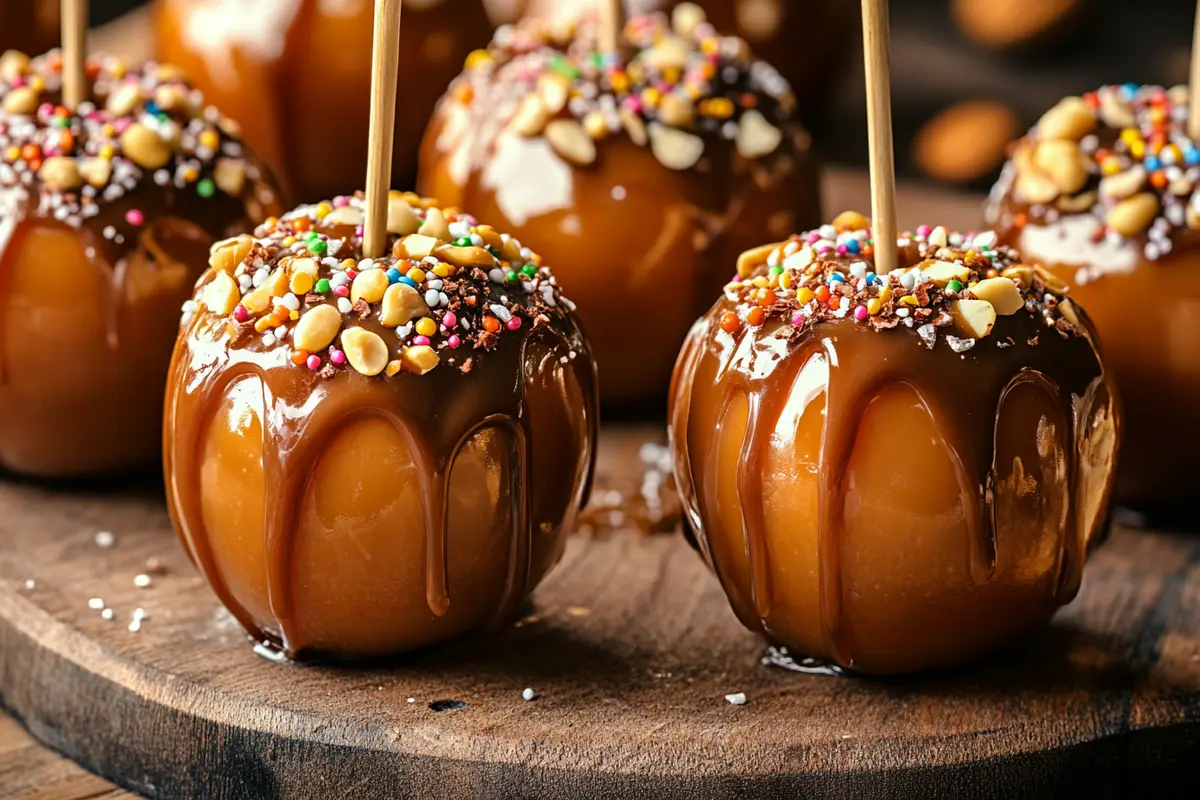Introduction
Caramel apples are a timeless treat that blends the crispness of fresh fruit with the rich, creamy sweetness of caramel. But let’s be real: not all apples are created equal when it comes to creating that perfect balance of flavors and textures. Choosing the right apple can make or break your caramel apple experience. In this article, we’ll explore which apples are best for caramel apples, diving into flavor profiles, textures, sizes, and even the preparation process. By the end, you’ll be equipped with all the knowledge you need to make caramel apples that are as delicious as they are visually stunning. Let’s dive in!
The Delight of Caramel Apples
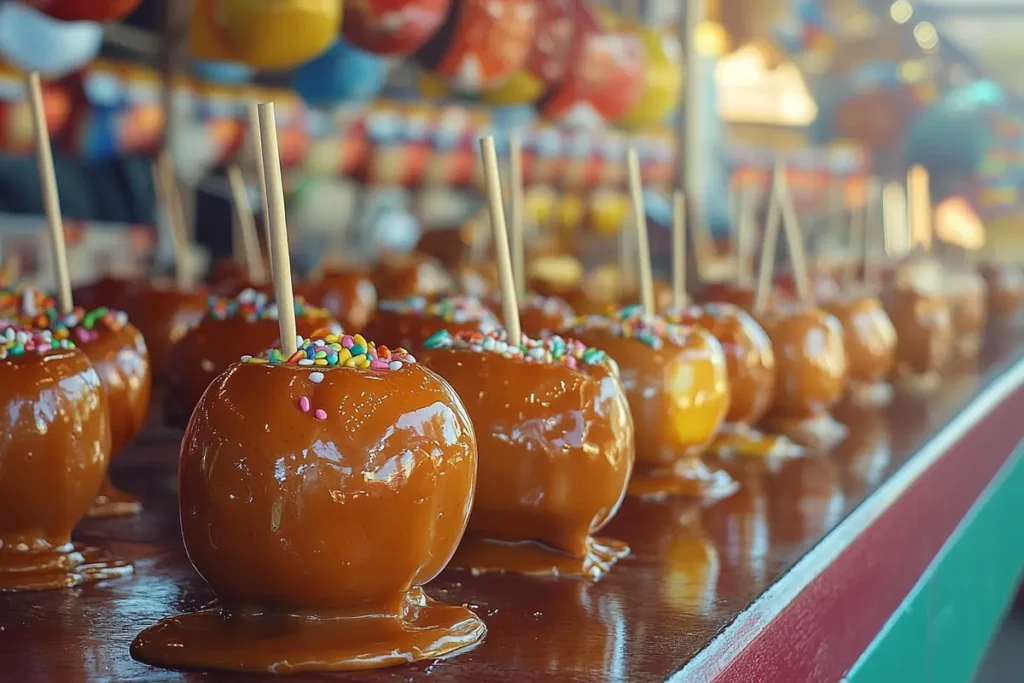
A Brief History of Caramel Apples
Caramel apples date back to the early 20th century, gaining popularity when candied fruits became trendy. By the 1950s, someone answered the question, “Which apples are best for caramel apples?”, by pairing apples with caramel to balance tartness and sweetness. This simple yet genius combination created a classic treat loved worldwide.
Despite their straightforward history, caramel apples evoke joy wherever they’re found—at fairs, fundraisers, or your kitchen—offering warmth, nostalgia, and pure indulgence in every bite.
The Importance of Apple Selection in Caramel Apples
Let’s get one thing straight: when it comes to which apples are best for caramel apples, the choice matters—a lot! Not all apples pair well with caramel. Some are too soft to support the caramel, while others are overly sweet, making the treat cloying.
To create the perfect caramel apple, you need a variety that balances tartness and sweetness while offering a satisfying crisp texture. A firm apple also ensures the caramel adheres beautifully, avoiding the dreaded “slip-off.” With the right apple, every step—dipping, decorating, and enjoying—becomes effortless and delightful.
Why Flavor and Texture Are Key
The essence of discovering which apples are best for caramel apples lies in their flavor contrast and texture. Tart apples like Granny Smith are top picks because their tangy flavor cuts through caramel’s richness, creating a beautifully balanced bite. If you prefer a sweeter, more indulgent option, varieties like Honeycrisp or Fuji work wonderfully.
Equally important is texture. No one enjoys a mushy caramel apple! A crisp, firm apple guarantees a satisfying crunch that pairs perfectly with soft, sticky caramel. By focusing on these two factors—flavor and texture—you’re well on your way to creating caramel apple perfection.
Factors to Consider When Choosing Apples for Caramel Apples
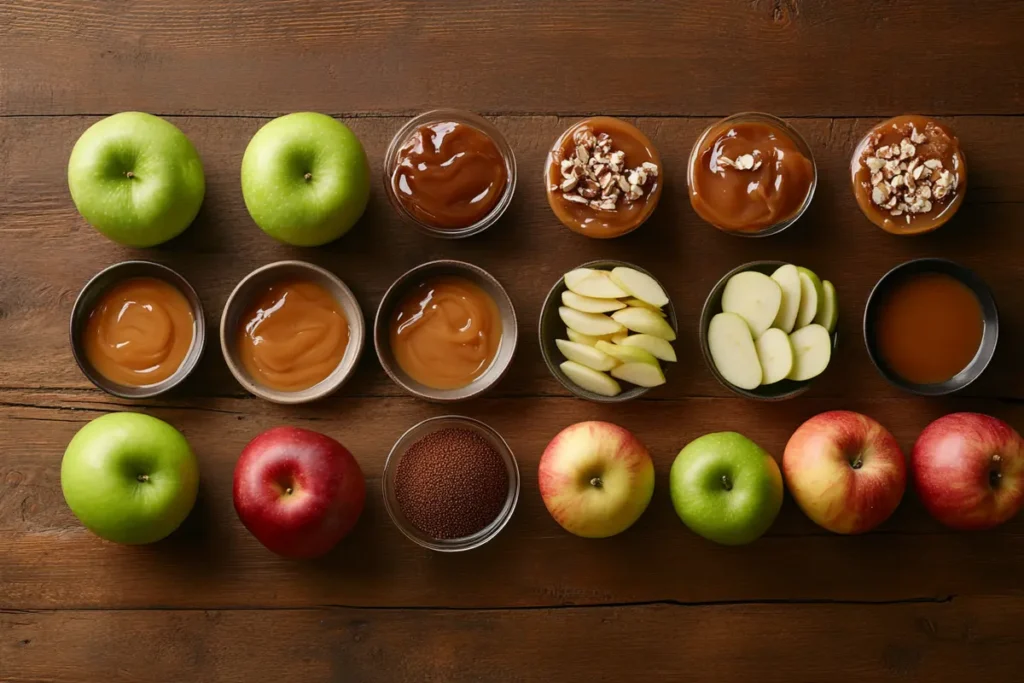
Key Factors in Selecting Apples for Caramel Apples
Choosing which apples are best for caramel apples goes beyond preference—it’s about finding the right balance of flavor, texture, and size. The apple should complement the caramel’s sweetness, provide a crisp crunch, and support toppings. With the perfect apple, your caramel apples can go from good to unforgettable.
Flavor Profile: Balancing Sweetness and Tartness
The flavor of the apple is key when deciding which apples are best for caramel apples. Tart varieties like Granny Smith are classics for their tangy contrast to caramel’s sweetness, while sweeter options like Fuji or Honeycrisp create a dessert-like treat. For a balanced choice, Pink Lady or Jonagold offer a mix of tartness and sweetness. Picking the right flavor ensures every bite is perfectly satisfying.
Texture: Ensuring Crispness and Freshness
Texture is crucial when deciding which apples are best for caramel apples. Firm varieties like Honeycrisp or Cameo provide a satisfying crunch and hold up well under caramel and toppings. Fresh apples are ideal—avoid soft or overripe ones that may collapse. Choose firm, bruise-free apples for the best results.
Size and Shape: Achieving the Ideal Caramel-to-Apple Ratio
When considering which apples are best for caramel apples, size plays an important role. Smaller apples provide the ideal caramel-to-apple ratio, are easier to eat, and create less mess—perfect for kids and adults alike.
Shape matters too! Round, uniformly sized apples ensure an even caramel coating, while irregular or overly large apples can lead to uneven dipping and waste. Choosing the right size and shape makes for picture-perfect caramel apples every time.
Freshness: The Role of Apple Freshness in Caramel Adhesion
Freshness is essential when deciding which apples are best for caramel apples, as it impacts flavor, texture, and caramel adhesion. Freshly harvested apples typically have less wax, helping caramel stick better.
For store-bought apples, wash them in warm water with vinegar or lemon juice to remove wax and ensure a smooth, glossy coating. Fresh apples not only look better but also enhance the overall taste, making your caramel apples truly irresistible.
Top Apple Varieties for Caramel Apples
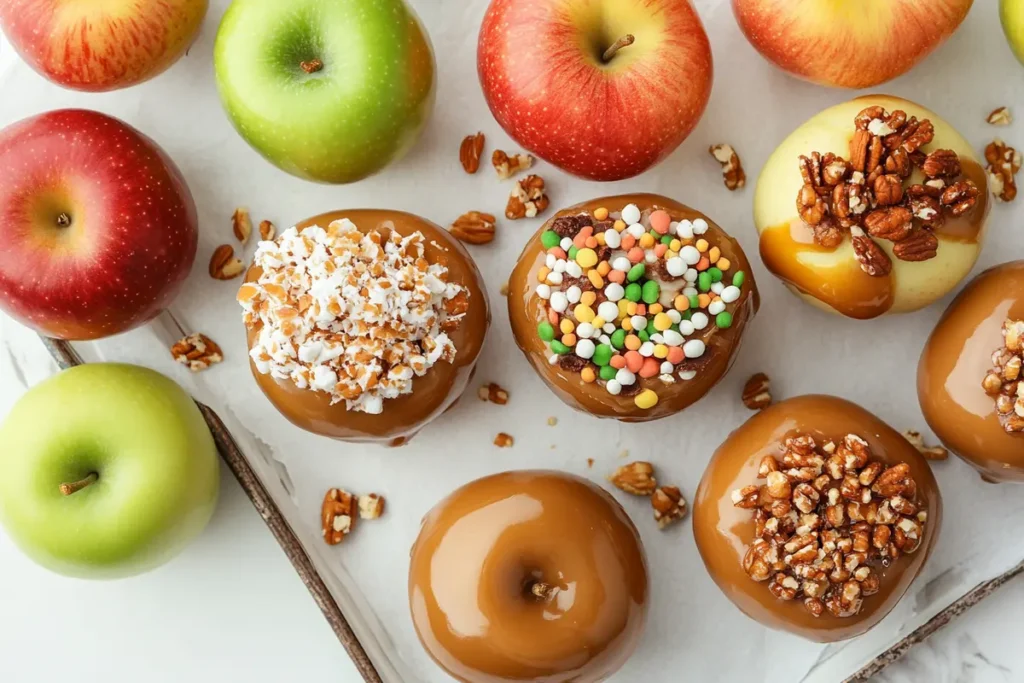
Recommended Apple Varieties for Caramel Apples
When deciding which apples are best for caramel apples, it’s essential to know which varieties excel in flavor, texture, and durability. While Granny Smith apples are often the go-to choice, there’s a world of delicious options to explore. From tart classics to sweet, modern varieties, each apple brings something unique to the table. Let’s uncover the best apples for crafting perfect caramel apples.
Granny Smith Apples: The Classic Choice
Granny Smith apples are a top choice when deciding which apples are best for caramel apples. Their tart flavor contrasts perfectly with caramel’s sweetness, creating an ideal balance. Their crisp texture supports caramel and toppings effortlessly, while their vibrant green color adds visual appeal. For a fail-proof caramel apple, Granny Smith is the way to go.
Honeycrisp Apples: A Sweet and Juicy Option
If you prefer a sweeter option when deciding which apples are best for caramel apples, Honeycrisp apples are an excellent choice. Their natural sweetness pairs beautifully with caramel’s richness, while their crisp texture provides a satisfying crunch. With their vibrant red-and-yellow hue, Honeycrisp apples are as visually appealing as they are delicious, delivering a flavorful burst in every bite.
Fuji Apples: Combining Sweetness and Firmness
Fuji apples are a fantastic choice when considering which apples are best for caramel apples. They offer a perfect balance of sweetness and firmness, making them ideal for caramel coating. Their dense texture keeps the caramel securely in place, while their juicy, sugary flavor adds a touch of indulgence. Fuji apples are perfect for those who prefer a sweeter caramel apple with a satisfying crunch.
Pink Lady Apples: A Balanced Flavor Profil
Pink Lady apples are an excellent choice when considering which apples are best for caramel apples. They balance sweetness and tartness perfectly, offering a versatile flavor profile. With a crisp texture and beautiful blush-pink color, they add sophistication and are a favorite for well-rounded caramel apple creations.
Jonathan Apples: A Traditional Favorite
Jonathan apples are a classic variety with a mildly tart flavor that pairs beautifully with caramel. Their deep red skin and firm texture make them visually striking and practical for caramel apple making. If you’re after a more traditional choice, Jonathan apples won’t disappoint.
Jonagold Apples: A Blend of Jonathan and Golden Delicious
As a hybrid of Jonathan and Golden Delicious apples, Jonagold offers the best of both worlds. They’re sweet yet slightly tangy, with a firm texture that holds up well to caramel. These apples are perfect for creating a rich, flavorful caramel apple that’s both indulgent and refreshing.
Cameo Apples: Crisp and Sweet
Cameo apples are known for their crispness and honey-like sweetness. They’re an excellent choice for those who enjoy a sweeter caramel apple without losing the crunch. With their attractive red-and-yellow skin, Cameo apples are as visually delightful as they are delicious.
Pippin Apples: A Tart Alternative
If you love tart flavors, Pippin apples are a fantastic option. Their tangy taste cuts through the caramel’s sweetness, creating a bold and satisfying contrast. Pippin apples are also firm and hold up well during the dipping process, making them a reliable choice for caramel apples.
SweeTango Apples: A Newer Contender
SweeTango apples are a newer variety that has quickly gained popularity. They combine the sweetness of Honeycrisp with a slight tartness, making them an excellent choice for caramel apples. Their crisp texture and vibrant color make them stand out as a modern favorite.
Preparing Apples for Caramel Application
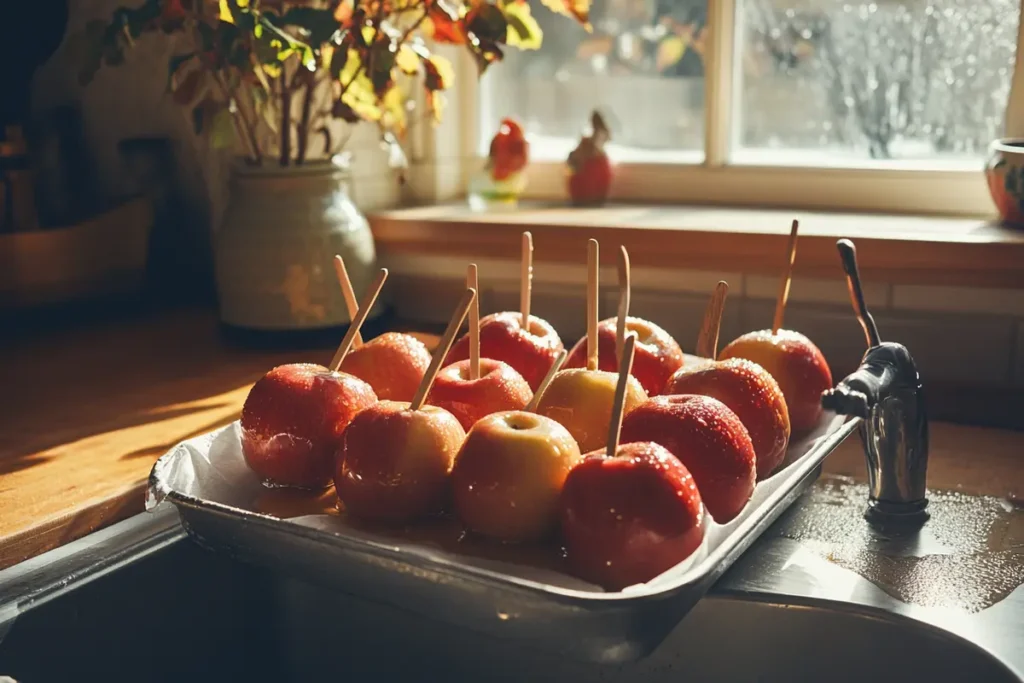
Preparing Apples for Caramel Coating
The preparation process is a crucial step when making caramel apples. Even the best apples for caramel apples won’t reach their full potential without proper prep. From cleaning to inserting sticks, each step ensures your caramel apples are picture-perfect and delicious.
Cleaning: Removing Wax and Residue
When deciding which apples are best for caramel apples, it’s crucial to prepare them properly. Store-bought apples often have a wax coating that hinders caramel from sticking. Wash them in warm water with vinegar or lemon juice and gently scrub to remove residue. This simple step ensures smooth caramel adhesion and a glossy, even finish.
Drying: Ensuring a Dry Surface for Caramel Adhesion
Once cleaned, it’s essential to dry the apples thoroughly. Even a small amount of moisture can cause the caramel to slip off. Use a clean towel to pat the apples dry, ensuring no water remains on the surface. A dry apple is key to achieving a flawless caramel coating.
Inserting Sticks: Techniques for Stability
When preparing which apples are best for caramel apples, inserting sticks is key for stability. Use sturdy wooden sticks or skewers, pushing them firmly into the apple just before the core. This keeps the apple secure during dipping and handling, making your caramel apples easier and more enjoyable to eat.
Making the Perfect Caramel for Apples
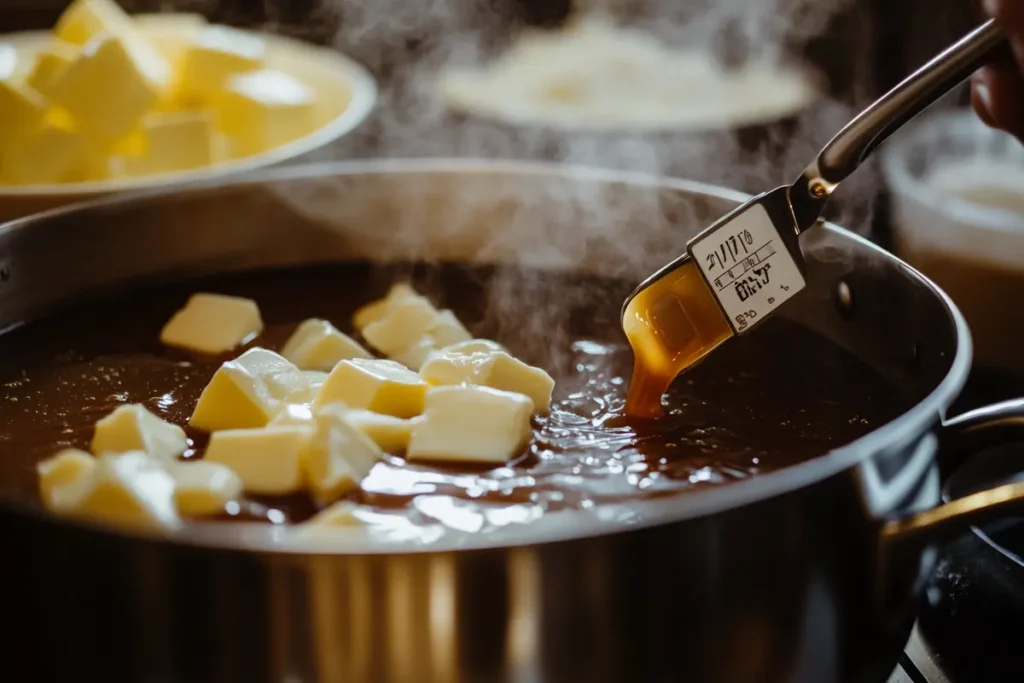
Crafting the Ideal Caramel Coating
A flawless caramel coating transforms caramel apples from ordinary to extraordinary. When deciding which apples are best for caramel apples, pairing them with perfectly made caramel is essential. Whether using store-bought caramel or making it from scratch, focus on quality ingredients, precise cooking, and troubleshooting. Attention to detail ensures your caramel apples are irresistibly delicious!
Ingredients: Selecting Quality Components
The secret to perfect caramel starts with quality ingredients. For a rich, creamy flavor, choose high-quality butter, heavy cream, sugar, and vanilla extract. Avoid margarine or low-fat substitutes, as they can compromise texture and taste.
If you’re short on time, store-bought caramels are a convenient option—simply melt them with a splash of heavy cream for a smoother consistency. No matter the method, using premium ingredients guarantees a delicious caramel coating that complements which apples are best for caramel apples.
Cooking Process: Achieving the Right Consistency
Getting the right caramel consistency is key when determining which apples are best for caramel apples. If the caramel is too thin, it will slide off; too thick, and it’s hard to dip. Cook over medium heat, stirring constantly, until it reaches 240–245°F on a candy thermometer (soft-ball stage).
This temperature ensures caramel that evenly coats the apples while staying pliable for toppings. Work quickly, as caramel hardens as it cools. With practice, you’ll perfect the timing and technique for flawless caramel-coated apples.
Troubleshooting Common Caramel Issues
Even with careful planning, caramel issues can arise. If it’s too runny, it likely hasn’t cooked long enough—just return it to the heat. If it’s too thick, stir in a splash of heavy cream to loosen it.
To keep caramel from sliding off, ensure the apples are clean, dry, and wax-free. If the caramel hardens too quickly, reheat it gently over low heat while stirring. Troubleshooting these issues ensures your caramel apples turn out flawless, no matter which apples are best for caramel apples.
Dipping Techniques and Toppings
Mastering the Art of Dipping Apples in Caramel
When it comes to caramel apples, presentation is everything. Mastering the dipping process ensures an even, glossy caramel coating that adheres perfectly to the apples. With a few simple techniques, your caramel apples will look just as good as they taste.
Dipping Process: Ensuring Even Coating
For a smooth, even caramel coating, tilt the pan and roll each apple to ensure full coverage. Hold the apple over the pan, letting excess caramel drip off while gently twirling it to avoid pooling at the bottom.
Use a heat-resistant spatula to smooth out any gaps or uneven areas. Work quickly, as caramel sets in minutes. This technique ensures your apples are coated beautifully, no matter which apples are best for caramel apples.
Topping Ideas: Enhancing Flavor and Texture
Toppings make caramel apples truly special. From classic crushed peanuts to creative choices like crushed cookies, pretzels, or candy pieces, the options are endless. Sprinkle toppings immediately after dipping while the caramel is soft and sticky.
For extra flair, drizzle melted or white chocolate over the apples for added flavor and artistic appeal. When paired with which apples are best for caramel apples, the right toppings elevate your treat to an irresistible level of deliciousness.
Setting: Allowing Caramel to Firm Properly
After dipping, place caramel-coated apples on a parchment-lined tray, ensuring they’re spaced apart to prevent sticking. Let the caramel cool and firm completely at room temperature for 30–60 minutes.
Rushing this step can cause uneven textures or sticky surfaces. Patience is crucial for caramel apples that are both visually stunning and easy to handle. No matter which apples are best for caramel apples, proper setting guarantees a delightful treat for any occasion.
Frequently Asked Questions
Are red or green apples better for caramel apples?
It depends on your flavor preference. Green apples, like Granny Smith, are tart and create a contrast with the sweet caramel, making them a classic choice. On the other hand, red apples, such as Honeycrisp or Fuji, are sweeter and deliver a dessert-like experience. Both options can be excellent depending on the taste you want to achieve.
Are Gala apples good for caramel apples?
Yes, Gala apples can work well for caramel apples. While they are sweeter than tart varieties, their crisp texture holds up under the caramel coating. Gala apples are a great choice if you prefer a mild, sweet flavor and a juicy bite. However, their sweetness may make the overall treat less balanced compared to tart apples like Granny Smith.
What kind of apples are best for dipping?
The best apples for dipping into caramel are those that are firm, crisp, and fresh. Varieties such as Granny Smith, Honeycrisp, and Pink Lady are excellent because they hold up well under the caramel and provide a satisfying crunch. Additionally, choosing apples with a slight tartness enhances the flavor contrast with the sweet caramel.
What apples are best for apple dessert?
When it comes to desserts, versatile apples like Granny Smith, Fuji, and Jonagold are top choices. Granny Smith offers tartness that balances sweet dessert components, while Fuji adds natural sweetness. Jonagold combines both qualities, making it ideal for pies, tarts, and caramel apples alike. These apples maintain their structure when baked or coated, ensuring a perfect texture.
Concluding Thoughts on Choosing the Best Apples for Caramel Apples
Selecting which apples are best for caramel apples is an art that involves balancing flavor, texture, and presentation. From the tart Granny Smith to the sweet Honeycrisp, each variety brings something unique to this classic treat.
The right apple can transform a simple caramel apple into an unforgettable experience. Prioritize firm, crisp apples to ensure a satisfying crunch, and choose varieties that complement caramel’s richness. Whether you’re crafting caramel apples for a festive occasion or a fun family activity, your choice of apple makes all the difference. Experiment with different varieties and toppings, and let your creativity shine!

